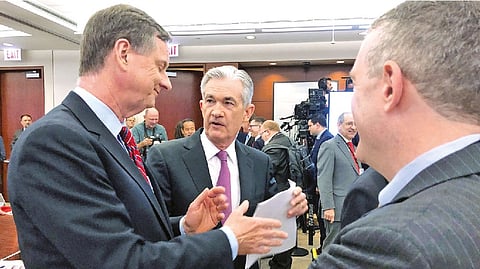

AT this year’s Jackson Hole symposium, a major event on the calendars of the world’s central bankers, US Federal Reserve Chair Jerome Powell delivered an uncharacteristically strong message about how the Fed plans to combat today’s high inflation.
The Fed raised interest rates sharply, by 75 basis points, in both June and July, but Powell made it clear that the rate hikes are unlikely to stop there or even to taper off. Instead, he said, “unusually large” rate increases will continue into the near future. The coming hikes will hurt US households and businesses, but “a failure to restore price stability would mean far greater pain.”
Powell’s hawkish remarks caused the S&P 500 to fall by 3.4%, with every sector of the index declining. Many fear that if the Fed continues to raise interest rates in large increments, as Powell suggested, investment will plummet and unemployment will rise. In fact, aggressive monetary tightening would cause the economy, financial markets, and people’s well-being to suffer excessively.
Like an overdose of steroids, it may cure the illness but at a disproportionately high cost. The Fed’s mistake reflects a misreading of the US labour market, which Powell noted “is particularly strong.” And it is indeed true that US wages have been rising sharply. Average hourly wages increased by 5.2% year on year in July, and are rising faster than the prices of many goods.
But it is wrong to equate current strong wage increases with inflation. That is because the COVID-19 pandemic has provided an intriguing twist to a standard economic argument in the form of the “Great Resignation.” This strange phenomenon, whereby many Americans who left the labour market during the pandemic because of workplace and school closures are not returning, even as COVID-19 wanes, has revealed a labour-market equilibrium that was previously hidden from view. It is like seamount that becomes a visible island only when the water level recedes.
Consider a typical American family, with two adults and some children. When hourly wages are very low, both adults probably must work full-time to earn enough income to meet the household’s basic needs. But if hourly wages were substantially higher, the adults would choose to work fewer hours, so that they could take turns to be at home in order to attend better to their children’s needs. (Alternatively, one adult might stay at home altogether or do some light work.)
Suppose that the economy is settled in the former, low-wage equilibrium in which both parents work full-time. Because all households do the same, there is a large supply of labour on the market.
That keeps the hourly wage rate low, which in turn means both parents must continue working full-time. The equilibrium persists. Now suppose there is a major pandemic, and children cannot go to school. Even in low-income households, at least one adult must stay home to look after small children. Later, as the pandemic eases and children return to school, there is bound to be a lag in adults returning to in-person work.
As creatures of habit, many people become accustomed to working from home, or just not working. So, as markets begin to return to normal, there is a shortage of labour and wages are bound to rise. Eventually, even after the habit wanes, the economy can end up at the other, higher-wage equilibrium that always existed in dormancy.
Once this equilibrium is reached, even though wages are high, the labour market will be tight, with no glut of job seekers, and it will remain there. Many have noted that relatively few Americans are filing for unemployment benefits. This would be a surprise if the labour market was out of equilibrium, with many people looking for work. Clearly, that is not the case.
The economy has simply shifted to a higher-wage equilibrium, thanks to the big pandemic-induced jolt to the labour market. Part of the rise in US wages reflects this adjustment. To overlook this and regard current wage increases solely as the result of inflation can lead to an excessive policy reaction. That is the mistake the Fed will make if it persists in raising interest rates sharply. My argument is admittedly a theoretical one, but it can be easily assessed. The Fed has sufficient data and expertise to work out how much of the wage movement is simply a shift to the new equilibrium, and how much is a part of overall inflation.
My hunch is that, once the Fed completes this exercise, it will want to temper its policy response to today’s inflation. A less hawkish stance would minimise the adverse side effects of the Fed’s medicine and greatly benefit small and large US businesses, workers, and financial markets, and achieve the same results as far as inflation is concerned. Given that US monetary policy has a much bigger effect on other countries than vice versa, this could be a big relief for the global economy, too.
Kaushik Basu, a former chief economist of the World Bank and chief economic adviser to the Government of India, is Professor of Economics at Cornell University and a non-resident senior fellow at the Brookings Institution.
Visit news.dtnext.in to explore our interactive epaper!
Download the DT Next app for more exciting features!
Click here for iOS
Click here for Android